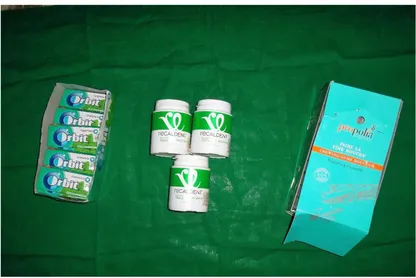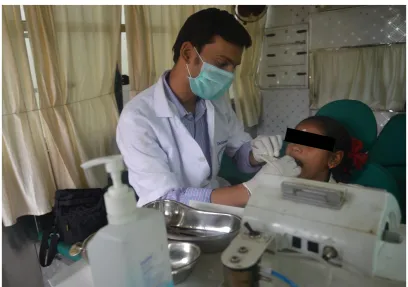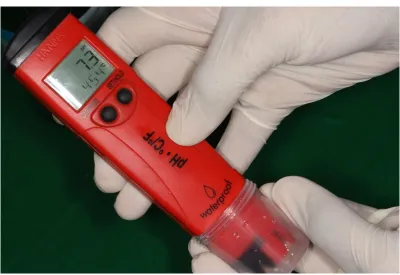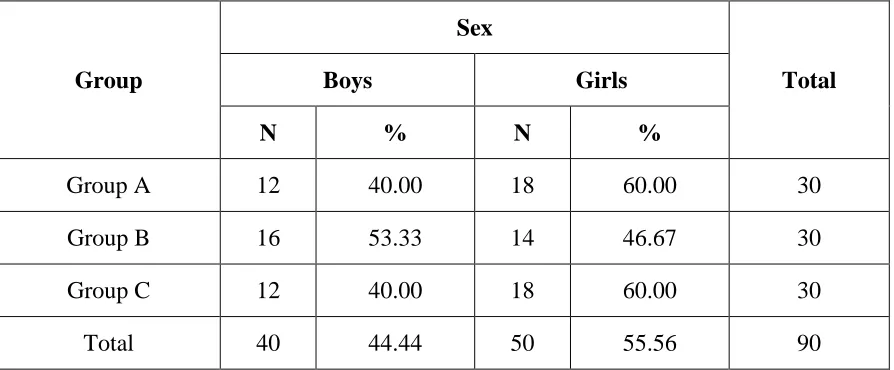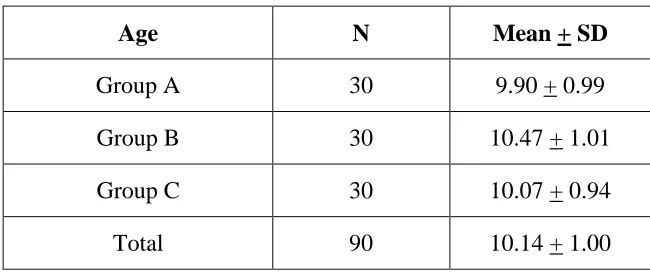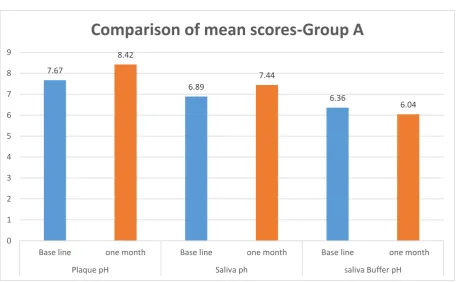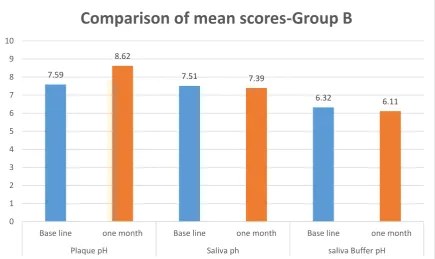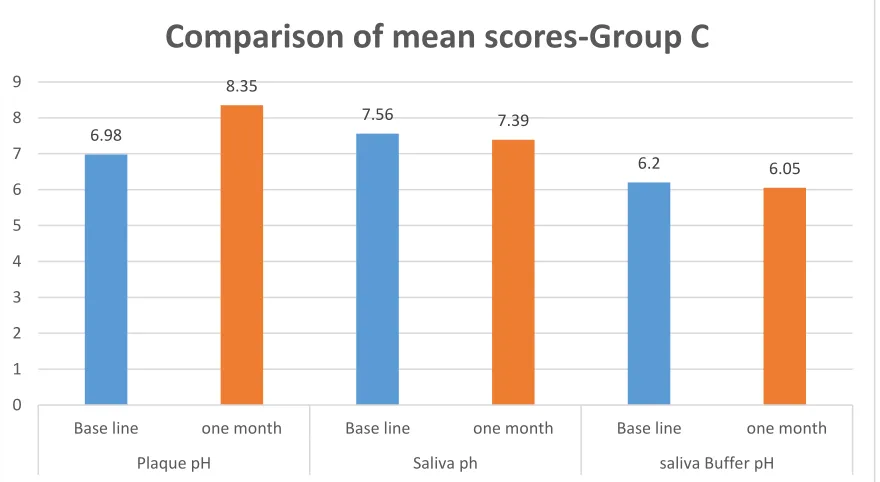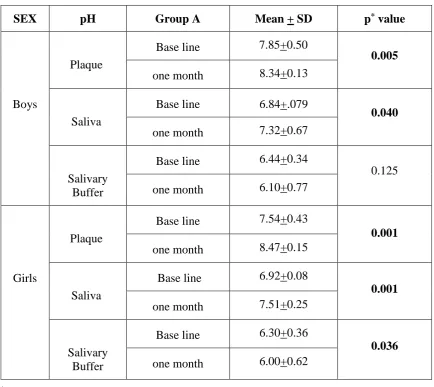buffering capacity in children-A Randomized Controlled Trial.
Dissertation submitted to
THE TAMILNADU Dr M.G.R. MEDICAL UNIVERSITY
In partial fulfilment for the degree of
MASTER OF DENTAL SURGERY
BRANCH – VIII
KSR INSTITUTE OF DENTAL SCIENCE AND RESEARCH
DEPARTMENT OF PEDODONTICS AND PREVENTIVE DENTISTRY
Certificate
This is to certify that the dissertation titled “Effect of different chewing gums
on plaque ph, salivary ph and buffering capacity in children - A Randomized
controlled Trial.” is a bonafide work done by Dr.M.Kameshwaran, Postgraduate
Student, during the course of thestudy for the degree of “Master of Dental Surgery”
in Department of Pedodontics and Preventive Dentistry, KSR Institute of Dental
Science and Research,Tiruchengode during the period of 2014-2017.
Dr. G.S. Kumar, M.D.S., Principal
Date:
KSR INSTITUTE OF DENTAL SCIENCE AND RESEARCH
DEPARTMENT OF PEDODONTICS AND PREVENTIVE DENTISTRY
Certificate
This is to certify that the dissertation titled “Effect of different chewing gums
on plaque ph, salivary ph and buffering capacity in children - A Randomized
controlled Trial.” is a bonafide work done by Dr.M.Kameshwaran, Postgraduate
Student, during the course of thestudy for the degree of “Master of Dental Surgery”
in Department of Pedodontics and Preventive Dentistry, KSR Institute of Dental
Science and Research,Tiruchengode during the period of 2014-2017.
Dr. Sharath Asokan, M.D.S., Ph.D
Professor and Head
Date:
DECLARATION BY THE CANDIDATE
TITLE OF DISSERTATION
Effect of different chewing gums on Plaque pH, salivary pH and buffering capacity in
children-A randomized controlled trial
PLACE OF STUDY K.S.R Institute of Dental Science and Research
DURATION OF COURSE 3 Years (2014-2017) NAME OF THE GUIDE Dr. Sharath Asokan HEAD OF THE DEPARTMENT Dr. Sharath Asokan
I hereby declare that no part of the dissertation will be utilized for gaining financial assistance for research or other promotions without obtaining prior permission from the principal, K.S.R Institute of Dental Science and Research, Tiruchengode. In addition, I declare that no part of this work will be published either in print or electronic without the guide who has been actively involved in this dissertation. The author has the rights reserved for publishing the work solely with prior permission of the principal, K.S.R Institute of Dental Science and Research, Tiruchengode.
CONTENTS
S.NO
TITLE
PAGE NO.
1. INTRODUCTION 1
2. AIM AND OBJECTIVES 10
3. REVIEW OF LITERATURE 11
4. METHODOLOGY 19
5. RESULTS 30
6. DISCUSSION 41
7. SUMMARY AND CONCLUSION 50
8. REFERENCE 54
Introduction
Among oral diseases, dental caries is the most common chronic disease of mankind. It affects all people regardless of their sex, socioeconomic strata, race, and age. It is also profoundly affected by other factors like diet, saliva and oral hygiene. During recent years, there have been signs of increased caries prevalence in children in developing countries (Haugejorden 2002, Oscarson P 2006).34, 74 However, there was a considerable decline in prevalence throughout the later periods of the twentieth century, chiefly attributed to the awareness and commitment of people to maintain a healthy diet, high level of oral hygiene and increased use of fluorides (Marthaler 2003).66
Preventive strategies tend to focus on dietary modification and the use of fluoride and pit and fissure sealants to increase the host resistance. Substitution therapy replacing harmful habit (excessive sucrose consumption) with a more positive practice can lead to a promising caries control strategy (Alamoudi NM 2011).3
Fluorides, which are a symptomatic approach to tooth decay, enhance the resistance of the tooth surface. Another way to combat the event of tooth decay is to use therapies that act on microorganism interaction with oral ecology (Twetman, 2004).101
Oral ecology
i) Oral bacteria
Shifts within the composition of the microflora could incline individuals towards diseases. The oral mucosa acts as the principal habitat of salivary bacteria. Oral tissues continually shed mucosal cells and therefore the bacterium is engulfed along with the cells. Therefore, from a bacterial survival point of view, the non-shedding surfaces of the teeth are quite enticing. (Paster 2001, Socransky SS and Haffajee AD 2005).77, 89
The bacteria will assist in the development of decay in many ways in which the foremost cariogenic cluster is mutans streptococci (MS), particularly S. mutans, S. Sobrinus and S.mutans colonize primarily fissures and grooves and S. sobrinus chiefly smooth surfaces (de Soet JJ 1991).18 The MS is primarily related to the initiation and will not contribute to the caries lesion into dentin (Ikeda T 1973, Edwardsson S 1974).39, 24 When these bacterium has the opportunity to grow without mechanical disturbance, they can cause caries (Marsh PD 1994).65
ii) Dental plaque
Dental plaque is the general term for the diverse microbial community located on the tooth surface, integrated into a matrix of polymers of bacterial and salivary origin. Plaque develops naturally on teeth and provides an example of a biofilm. Under stable conditions, a homeostasis with the host occurs. The pathogenic potential of the dental plaque is dependent on the number and type of the resident microflora. Cariogenic plaque normally contains high numbers of MS and lactobacilli. This kind of dental plaque has a good acidogenic potential.
5.7. If these low hydrogen ion concentration levels are reached typically, the chance for tooth decay will increase (Sheiham A 1983).88
iii) Saliva
Salivary flow comes mainly from the three major salivary glands – the parotid, submandibular and sublingual glands – as well as from the minor glands in the oral mucosa. The saliva contains more than 99% water and less than 1% solid, such as proteins and electrolytes. The electrolytes include calcium and phosphate and, the proteins include mucins and mucoproteins, which contribute to pellicle formation. Saliva also contains sodium, potassium, and magnesium and small amounts of many other inorganic components. The pH-value of normal whole saliva varies between 6.8 and 7.2 (Fejerskov O and Kidd E 2008).26
The daily production of saliva ranges from 0.5 and 1 litre. The flow rate of unstimulated saliva is normally 0.25-0.35 ml/min (in adults), and stimulation, such as using chewing gum, may increase the flow rate to more than 1.0 ml/min. Values below 0.7 ml/min are considered as hyposalivation, and values 0.7 – 1.0 ml/min low (Tenovuo J and Lagerlof F 1994).95 In children, the amount of saliva secretion increases with age. The salivary flow rate is influenced by many factors, such as the nutrition, mood, season, and time of the day etc. (Dawes C 1987).16
substances that are introduced into the oral cavity. This is a physiological process and the focus has been on how the saliva takes care of sucrose, i.e. “Sugar clearance”. The salivary sugar clearance rate and other salivary parameters vary for each subject, an example is the salivary flow rate and the volume present in the mouth immediately before and after swallowing (Dawes C 1983; Lagerlof F1994).15,53
The salivary buffers like phosphate, bicarbonate and the proteins tend to maintain a constant pH of saliva. However, the most important salivary buffer system, the bicarbonates buffers acids produced by bacteria, and can restore the pH in dental plaque to the same level as before acid production. The amount of bicarbonate increases with the salivary flow rate. Bicarbonates has the ability to take up hydrogen ions to form carbonic acid.
CO2 + 2H2O ⇌ H2CO3 + H2⇌ HCO3 − + H3O¯
(The bicarbonate system is based on this chemical equilibrium. The reaction is catalysed by the enzyme carbonic anhydrase.)
If the concentrations of carbonic acid increase, more carbon dioxide is formed in saliva and bicarbonate can bind hydrogen ions. At a pH above 5.5, the bicarbonate buffering system has a high buffering capacity (Dowd FJ 1999).20
iv) Sugar
Sugar is the generic name for the simpler forms of carbohydrates, including: monosaccharides, disaccharides, trisaccharides and oligosaccharides. Monosaccharides and disaccharides are sometimes named according to the food on which they are found. For example “milk sugar” refers to lactose and “fruit sugar” refers to fructose (Moynihan PJ 1998).71
countries changed with an increase of dental caries as a side effect (Sreebny LM 1982).93 The Vipeholm study established that sugar consumed at meals did not have the same caries potential as if consumed between meals (Gustafsson B 1954, Zero DT 2004).33, 110 The annual per capita consumption of sucrose has been fairly stable in Sweden during the last 50 years, but showed a sudden increase in last few years. (Swedish Board of Agriculture, 2006).12
Sugar substitutes and sweeteners
Because bacteria that produce acids from sugars can cause caries, it has been a challenge to find sugar substitutes and artificial sweeteners. Sugar substitutes include lactitol, maltitol, mannitol, sorbitol, isomalt, and xylitol and are commonly used in foods to replace sugars (Moynihan PJ 1998).71 These are polyols (sugar alcohols) and are generally considered as more tooth friendly since they do not contribute to the formation of organic acids and the plaque matrix (Kalfas S 1990).45
Acesulfame-K, Aspartame, Cyclamate and Saccharin are artificial sweeteners and not accepted as a source of nutrients by the cariogenic bacteria and do not decrease plaque-pH. They do not give any calories compared to other sugar substitutes, while sorbitol gives 4.0 kcal (kilocalorie)per gram and xylitol gives 2.4 kcal per gram.
Sorbitol
may increase. Too much sorbitol can cause diarrhoea (>20-30g). Maltitol and mannitol are used in combination with sorbitol and act on plaque as sorbitol does.45
Xylitol
Xylitol is a five carbon polyalcohol, which is widespread in nature. Most fruits, berries, and plants contain xylitol (Washuttl J 1973)107 listed the richest natural sources of
xylitol to be plums, strawberries, raspberries, cauliflower, and endives. In human metabolism, 5-15g of xylitol is formed daily (Hollman S 1964).37 Xylitol, metabolised in the liver, is transformed into D-xylulose and glucose by polyol dehydrogenase. Activity from this enzyme may induce and select intestinal microflora (Krishnan R 1980, Bassler KH 1969).51, 8 The absorption rate of ingested xylitol is quite slow and high oral doses may induce osmotic diarrhoea. Unadapted adults can consume 30-60g oral xylitol per day without side effects, while after adaptation the dose can be increased up to 400g daily (Makinen KK and Scheinin A 1975).60 Xylitol can be utilized in the diet of diabetics. As it is slowly absorbed, the initial metabolic steps are independent of insulin and it does not cause rapid changes in blood glucose concentration (Forster H 1974).28
Other areas where xylitol seems to be useful are in preventing the transmission of Streptococcus mutans from mother to child (Soderling E 2000; Peldyak J, Makinen K 2002, Thorild I 2006)90,78,97 and in preventing acute otitis media (Uhari M 2000).102 These
Chewing gums
Chewing gum is defined as a “Solid preparation with a base consisting of gum which should be chewed and not swallowed, providing a slow steady release of medicine contained”. Gum can act as a salivary stimulant and has been claimed to ‘Cleanse’ the mouth. Finally, chewing gum has been proposed as a vehicle for the delivery of therapeutic additives (Marwaha M 2011).67
Sugared chewing gum may contribute to the cariogenicity of the diet. Sucrose chewing gum decreases plaque-pH (Edgar WM 1975)22 and clinical studies have demonstrated an increase in caries incidence with the use of sugared chewing gum (Glass RL 1981).32
The development of sugar free chewing gum provided the possibility of a non-cariogenic alternative to sugared chewing gum. Sugar free chewing gum seems to be more effective, but both sugared and sugar free chewing gums can significantly reduce the acid response (Manning and Edgar, 1993).61 Caries incidence is less in chewers of sugar free chewing gum compared with sugared gum (Makinen KK 1995a) 58 and this agrees with the plaque-pH results (Park KK 1995).75 As the chewing starts, the saliva secretion rate increases and the stimulation of the saliva are highest during the first few minutes. After 20 minutes, the flow is still increased (Dawes C, Macpherson LM 1992).14
ME 1986, Park KK 1990, Soderling E 1991).43, 76, 91 Sugar free chewing gum is a very practical and acceptable saliva stimulant after intake of sugar containing foods.
The plaque reducing effect of sugar free chewing gum seems to be more pronounced when the chewing gum contains xylitol (Makinen 1995a; Makinen 1995b).58,59 Other substances in chewing gums that may contribute to a decrease in caries development are urea, dicalcium phosphate, and sodium trimeta phosphate (Imfeld T 1995).41
Furthermore some recent methods for preventing dental caries also include the use of casein phosphopeptide-amorphous calcium phosphate (CPP-ACP) nanocomplexes which have been reported to be effective for remineralisation, and use of propolis which is a by-product of bee wax that has several medicinal values.
CPP-ACP is a milk derived protein characterized by its abundance of calcium and phosphate. It is mainly included in chewing gums and tablets.When delivered in sugar free chewing gum, CPP-ACP has also been shown to remineralize enamel subsurface lesion and reduce S.mutans in vivo, independent of chewing frequency and duration of use (Ogata K 2010).73
Propolis, on the other hand, a resinous and natural substance, which has gone unnoticed in spite of its potential uses in curing a variety of diseases. It contains resin and balsams (50–60%), pollen (5–10%), amino acids, minerals, vitamins A, B complex, the highly active biochemical substance known as bioflavonoid (vitamin P), phenols and aromatic compounds.
Aim
To determine changes in dental plaque pH, salivary pH and its buffering capacity after the use of three different chewing gums, in children aged 8-12 years in Tiruchengode, Tamil Nadu.
Objectives of the study
1. To evaluate the effect of three different chewing gums on dental plaque pH, salivary pH and its buffering capacity.
Review of literature
Gibbons RJ (1984)31stated that bacterial attachment to tooth and oral mucosa is the
first step in the colonization process, through hydrophobic ligands (bond) called adhesins. He also addressed a variety of factors that influence bacterial attachment like salivary characteristics, dietary lectins, and antibiotics that have the potential to have an impact on host-parasite interactions in the mouth.
Reynolds EC (1987)81 described the remineralization ability of bovine milk
phosphoprotein (casein) by incorporating into plaque, using an intra-oral appliance containing bovine enamel slabs. The enamel slabs were then exposed to various sugar and casein solutions. The caesin compounds have the ability to incorporate into plaque, and hence prevent enamel demineralization. This property increases plaque calcium-phosphate levels and its acid-buffering capacity indirectly through catabolism by plaque bacteria. It was inferred that the incorporation of casein and its breakdown in the plaque did not produce a significant change in the amount or composition of plaque bacteria.
Ikeno K, Ikeno T, Miyazawa C (1991)40 studied the effects of propolis on growth
Manning RH, Edgar WM (1992)62 stated that enamel demineralization and
remineralisation is balanced by increase in salivary pH and buffering capacity, due to the salivary stimulation that occurs during mastication. The study concluded that chewing gums after meals and snacks, enhances the remineralization capacity of mouth due to supersaturating characteristics of stimulated saliva.
Toors FA (1992)98 in a review, compared caries occurrence rate between sugar
based and sugar free gums. Sugar based gums caused a more pronounced fall in plaque pH resulting in an increased risk for caries occurrence. While xylitol a sugar free gum, showed an increase in plaque and salivary pH with reduction in S.Mutans level, and a good oral clearance rate due to salivary stimulation. It reduces the caries occurance by lowering the acidogenic potential of the plaque and S.Mutans adhesiveness to tooth surface. Thus he concluded that, Xylitol chewing gum is suited to be used as part of a caries preventive regimen preferably for high caries risk patients and those suffering from xerostomia, due to its salivary stimulating properties.
Wennerholm K, Arends J, Birkhed D, Ruben J, Emilson CG, Dijkman AG
(1994)108, compared the effect of four different concentrations of xylitol and sorbitol
Murray MC, Worthington HV, Blinkhorn AS (1997)72, compared the
effectiveness of propolis containing mouth rinse in the inhibition of plaque formation with chlorhexidine mouth rinse and a placebo. It was concluded that chlorhexidine containing mouth rinses was much significant over propolis in inhibiting plaque formation. While the propolis containing rinse was marginally better than the negative control (placebo).
Edgar WM (1998)23in his literature review, reported that both sorbitol and xylitol
chewing gums are non-cariogenic in contrast to sugared gums, and exhibit beneficial anticaries properties due to its increased salivary stimulation. In addition, the antibacterial properties of xylitol leads to caries reductions which was superior, when compared to the modest reduction seen with use of sorbitol gum.
Jin Y, Yip HK (2002)44 stated that super saturation of saliva and plaque fluid with
respect to calcium phosphates, is the driving force for plaque remineralization. Both salivary flow rate and plaque pH appear to influence the saturation of calcium phosphates intake into the tooth.They also reported the potential of fluoride to increase the plaque pH and promote remineralization. Hence chewing gum with properties to increase salivary calcium phosphates level and presence of fluoride, will have a desirable effect on pH levels and remineralization of tooth enamel.
Aksoy A, Duran N, Koksal F (2006)2 reported that Mastic gum, from Pistacia
wax) samples. Hence mastic gums can be considered as a useful adjunct in the prevention of caries.
Honkala E, Honkala S, Shyama M, Al-Mutawa SA. (2006)38conducted a survey
in 1999 and reported higher incidence of caries among physically disabled school children in Kuwait. In 2002 they did a field trial in two special schools in Kuwait with a follow up period of 18 months. Xylitol candies were distributed to children aged 8-12 years, three times during school day for a period of 18 months (after breakfast, lunch and before leaving school). When comparing the baseline decayed surface (DS) and decayed, missing and filled surface (DMFS) scores with follow up, it was concluded that xylitol has a strong preventive and remineralisation effect on caries, when used regularly for a period of 1.5 years (18 months).
Walker G, Cai F, Shen P, Reynolds C, Ward B, Fone C et al (2006)104assessed
the remineralisation of tooth enamel by consuming milk containing CPP-ACP. The study was conducted among ten healthy individuals 20-25 years of age, using intra-oral appliance with enamel slab incorporated in it and checked remineralisation using microradiography and microdensitometry. They described that remineralisation effect of CPP-ACP is dose dependent, and adding 2.0-5.0g of CPP-ACP to milk substantially increased its ability to re-mineralize enamel subsurface lesions by increasing its mineral content.
Duailibe SA, Goncalves AG, Ahid FJ (2007)21 evaluated the antibacterial action
Mickenautsch S, Leal SC, Yengopal V, Bezerra AC, Cruvinel V (2007)68 in a
systemic review analysed the therapeutic and anti-cariogenic effect of sugar free chewing gums. They reported that several studies demonstrated anti-cariogenic effects of chewing Sorbitol, Xylitol or Sorbitol/Xylitol gums. They reported that, anti-cariogenic effect of these gums were attributed to saliva stimulation through the chewing process, particularly when used immediately after meals. This results in lack of sucrose and the inability of bacteria to metabolize polyols into acids.
Manton DJ, Walker GD, Cai F, Cochrane NJ, Shen P, Reynolds EC (2008)63
compared the efficacy of three commercially available sugar-free chewing gums: Trident White, Orbit and Orbit Professional in remineralizing enamel subsurface lesions in situ (using removable palatal appliance with enamel slab). The chewing gums were given to ten healthy adults and were asked to chew four times a day for a period of 14 days. They concluded that the superior remineralisation activity was seen in Trident white gum in situ, which was attributed to the presence of casein phosphopeptide-amorphous calcium phosphate nanocomplexes.
Llena C, Forner L, Baca P (2009)54 reviewed the role of different Casein
Walsh LJ (2009)105 reviewed various anti-cavity tooth pastes. He stated that Recaldent (CCP-ACP) and Functionalised tri-calcium phosphate (fTCP) (formed by combining calcium carbonate and calcium hydrogen phosphate) containing dentifrices improved remineralization and prevent further demineralization by providing calcium, phosphate, fluoride and optimizing pH of oral cavity. He also stated that using fTCP can enhance the levels of calcium, phosphate in plaque fluid and saliva. Hence fTCP operates as a remineralizing agents at a neutral or alkaline pH and more efficient than CCP-ACP.
Vijayaprasad KE, Ravichandra KS, Vasa AA, Suzan S (2010)103 assessed the
possible relationship of calcium, phosphorus and alkaline phosphatase levels in saliva with incidence of caries in child patients 5-13 years of age with rampant caries and a control group . They stated that alkaline phosphatase activity was much significantly higher in caries prone (rampant caries) groups.
Marchisio O, Esposito MR, Genovesi A (2010)64 investigated the role of CPP in stabilizing and releasing ACP on the tooth surface to better understand its ability to prevent tooth demineralization in orthodontic patients. Twenty-Five patients with fixed orthodontic appliances were given CCP-ACP dentifrices for 3 weeks and then was suspended for next 3weeks.Followed by evaluation of salivary, plaque pH and oral hygiene index. The result showed an improved oral hygiene status and increase in salivary pH levels (76% of the patients) but only a marginal increase in the plaque pH (48% of the patient). In conclusion the results doesn’t give any substantial evidence towards the protective properties of recaldent molecule.
Dodwad V and Kukreja BJ (2011)19 investigated the effectiveness of a
marginally better than chlorhexidine in improving gingival health. They concluded that propolis might be used as a natural mouthwash, an alternative to chemical mouthwashes.
Marwaha M and Bhat M (2011)67 evaluated the antimicrobial effectiveness of
dosage and frequency of sugar-free chewing gums on Streptococcus mutans count. They concluded that there was reduction in the salivary Streptococcus mutans level, which could be due to mechanical cleansing effect of chewing gum rather than dosage and frequency of intake of sugar-free chewing gums.
Subramaniam P, Suresh Babu P (2011)94assessed the effectiveness of xylitol and
sorbitol chewing gums on levels of Streptococcus mutans in saliva. The study was conducted among 30 healthy males aged 13-17 years. They were instructed to use chewing gum 3 time a day after breakfast, lunch and dinner, for a period of 3 months. They concluded that salivary Streptococcus mutans levels showed a significant reduction with the use of xylitol based chewing gum than with sorbitol based chewing gum.
Santhosh BP, Jethmalani P, Shashibhushan KK, Subba Reddy VV (2012)85
studied the effect of CCP-ACP containing sugar free chewing gum on salivary concentration of calcium and phosphorus in school children aged 8-14 years. The samples were assessed for calcium and phosphorous concentration using reagent kits and photometer. They concluded that chewing of CPP-ACP containing chewing gum significantly increased the salivary concentration of calcium for a prolonged period of time. Hence it may help in the remineralisation of tooth surfaces.
Tulsani SG, Chikkanarasaiah N, Siddaiah SB, Krishnamurthy NH (2014)100
The present study was conducted in the Department of Pedodontics and Preventive Dentistry, KSR Institute of Dental Science and Research (KSRIDSR). The study design and protocol were analyzed and approved by the Institutional Review Board and Institutional Ethical committee of KSRIDSR, Tiruchengode, Tamil Nadu. The study was conducted at four different schools in Tiruchengode, western Tamil Nadu in South India. The study sample includes children aged 8-12 years.The purpose of the study was described to the school authorities and their approval was obtained. A written consent in local language (Tamil) was also obtained from the parents of the children who took part in the study.
ARMAMENTARIUM USED
1. Diagnostic instruments consisting of mouth mirrors, explorers and kidney trays. 2. 3.0 ml disposable pipette
3. 5.0 ml measuring pipette
4. 5.0 ml disposable test tubes with caps 5. Sterile sample container (Uri-cups)
6. 2-octanol solution (500ml) [Himedia Laboratories, Mumbai]
7. 0.0033 mol per l of HCl (37.4% concentration, dissolved in 1000ml of distilled water)
8. Hanna pH meter, model no 98127.[Hanna instruments, Texas] 9. Hanna pH calibration buffer solutions (for pH 4, 7, and 10). 10.Hanna pH meter storage solution.
11.Distilled water. 12.Gloves/ mouth mask. 13.Chewing gums:
c. Recaldent [Nihan Kraft Foods, Japan]
Inclusion criteria
1. Children with chronological age between 8 and 12 years, with DMFT / dmft score of < 3.
2. Healthy children with no history of medical problem or under medications, for past 6 months.
Exclusion criteria
1. Medically compromised children, children with any systemic diseases or allergies. 2. Children using fixed or removable orthodontic appliance or removable prosthesis 3. Children with presence of any intraoral soft tissue pathology.
4. Children with regular habitual use of sugar free containing products.(xylitol products)
Methodology
This was a randomized controlled double blinded clinical trial carried out for a duration of 30 days. Five hundred school children were screened and the study population (n=90 children) were included from four schools. The age group of children selected in present study belonged to concrete operational period according to Jean Piaget’s cognitive theory. Children in this stage of cognitive development have the concept of moral realism. They understand the concept of rules and recognize the sanctity of rules and that they have to play by them. This helps them to retain oral hygiene instructions and apply them when instructed repeatedly.79 The nature and design of the study was described in detail to the
Group A: Xylitol containing chewing gum. (Orbit, Wrigley India, Bangalore)
Group B: CPP- ACP containing chewing gum. (Recaldent, Nihan Kraft Foods, Japan) Group C: Propolis containing chewing gum. (Propolia, Apimab Laboratories, France)
All the children in three groups were first subjected to oral prophylaxis and were instructed not to practice any kind of oral hygiene measures for the next 48 hours. After 48 hours, the children were examined at the school premise before their morning break time (which was more than 2 hours after breakfast) to collect the baseline (unstimulated) saliva and plaque samples. The school authorities were advised to restrict any food 2 hours prior to the procedure (to avoid any kind of pH changes due to intake of food).50,52 They were then asked to rinse their mouth with distilled drinking water for 1 minute to get rid of any food debris. They were made to sit in a comfortable upright position, under natural light for saliva collection. They were also assured that the procedure was non-invasive, to reduce treatment related anxiety that may affect saliva stimulation.
The children were provided with a sterile container (uricup) and were instructed to expectorate saliva (2 ml) in the container, five minutes after the oral.35 Saliva was collected with their head tilted slightly forward and to rest for 5 minutes and minimize any oral movements. Children were instructed to allow saliva to pool in the mouth. They were also asked to imagine eating their favourite food to stimulate saliva. Saliva was collected by drool method and the procedure was repeated as often as necessary until the desired volume (2 ml) of saliva was collected. A minimum of 2ml saliva was needed for the bulb of the pH measuring electrode to dip sufficiently into the saliva samples.
sterile blunt probe. The technique used for plaque analysis was given by Fosdick (1957), later modified by Frostell J (1970) and Rugg-Gunn (1975). Each collected plaque sample was thoroughly mixed in a sterile container containing 20ml distilled water (measured by a pipette) and was dissolved.56 The collected samples were then transported to the laboratory, within 1 hour.35 Saliva and plaque samples were then subjected to pH measurements and buffer capacity to obtain the base line values.
The pH values for all salivary characteristics were assessed with the help of Hannah pH meter (HI98127 pHep®4 pH/Temperature Tester with 0.1 pH resolution). The pH meter was standardized using a standard protocol, using pH calibration solutions ranging from pH 4, 7 and 10. Following the manufacturer guidelines the head of the pH bulb was immersed in the calibration solution (pH 4, 7, 10), until the pH of the solution was determined correctly in all the three ranges. It was suggested that the pH meter be stored in the storage solution when not utilized. For saliva and plaque pH measurements, the pH meter bulb was completely immersed into the sample. It was necessary to wait till the reading stops fluctuating. The values displayed digitally were taken as baseline values.
For determination of salivary buffering capacity, Ericson’s test (1959)25 was employed. It was recommended to use 0.0033 mol per L of Hydrochloric acid (HCl) for unstimulated saliva. The desired HCl preparation was calculated using solcalc (solution calculator Inc) software. To prepare 1000 mL of a 0.0033 mol/L solution of hydrochloric acid, 0.273026 mL of 37.2% HCl was added with deionized (distilled) water. The HCl was collected using micropipette to obtain accurate volume for preparation.
determine the range of buffering capacity as high, normal, low and very low as shown in table.
Final pH Evaluation
More than 4.75 High
4.25-4.75 Normal
3.50-4.24 Low
Less than 3.50 Very Low
After baseline measurements, the 3 types of chewing gums were distributed to the three groups respectively. Children were instructed to use two chewing gums twice daily and to chew one pellet for 10 minutes. After 10 minutes the gums were discarded under the supervision of school authorities (class teacher), the gums were given at about 11 am in the morning (2 hours after breakfast) and 3 pm in the evening (2 hours after lunch). Chewing gums were refilled every three days. The routine was recorded in a register to ensure that all the groups received their ration of gums. No modifications were made in the diet or oral hygiene measures of the children, throughout this one month period.
Statistics
Study Protocol
Healthy school children aged 8-12 years of same socio-economic status (n=90)
GROUP A
Xylitol chewing gum. (n=30)
GROUP B
Propolis chewing gum. (n=30)
GROUP C
Recaldent chewing gum (n=30)
Instructed to chew 2 pellets a day for a period of 1 month Oral prophylaxis done
Baseline data obtained (plaque pH, salivary pH and buffering capacity)
Randomization
Post Intervention data collection (Plaque pH, salivary pH and buffering capacity)
Figure 1: Armamentarium
[image:37.595.96.512.453.731.2]Figure 3:Oral prophylaxis done in mobile dental van
Figure 4: Saliva sample collection by Passive drool method
Figure 5: Plaque sample collection using sterilized straight probe
[image:39.595.104.505.449.724.2]Table 1: Overall distribution of study population
Group
Sex
Total
Boys Girls
N % N %
Group A 12 40.00 18 60.00 30
Group B 16 53.33 14 46.67 30
Group C 12 40.00 18 60.00 30
Total 40 44.44 50 55.56 90
Table 1 shows overall distribution of study population based on gender. Out of 90 school children selected for study, 44.4% (n=40) were boys and 55.5% (n=50) were girls.
40.00 53.33 40.00 60.00 46.67 60.00 0 10 20 30 40 50 60 70
Group A Group B Group C
Per
ce
n
tage
[image:42.595.106.505.461.701.2]Table 2:Mean age group of study population
Table 2 shows the mean age group of the study population. In this study the total mean age of the three groups was 10.14 years.
9.6 9.7 9.8 9.9 10 10.1 10.2 10.3 10.4 10.5
Group A Group B Group C
9.9
10.47
10.07
Mean Age
Age N Mean + SD
Group A 30 9.90 + 0.99 Group B 30 10.47 + 1.01 Group C 30 10.07 + 0.94
[image:43.595.101.512.439.669.2]Table 3:Intragroup comparison of mean score of plaque pH, saliva pH and buffer pH at base line and after one month – Group A
Group A Mean + SD p* value
Plaque pH
Base line 7.67 + 0.48
0.001
one month 8.42 + 0.16
Saliva pH
Base line 6.89 + 0.09
0.001
one month 7.44 + 0.47 Salivary
Buffer pH
Base line 6.36 + 0.36
0.008
one month 6.04 + 0.68 *Paired t test
Table 3 shows a significant difference in the mean scores of plaque pH, saliva pH and buffer levels, between baseline and one month after the use of chewing gum in group A. 7.67 8.42 6.89 7.44 6.36 6.04 0 1 2 3 4 5 6 7 8 9
Base line one month Base line one month Base line one month
Plaque pH Saliva ph saliva Buffer pH
[image:44.595.90.547.461.743.2]Table 4:Intragroup comparison of mean score of plaque pH, saliva pH and buffer pH at base line and after one month – Group B
Group B Mean + SD p* value
Plaque pH
Base line 7.59 + 0.43
0.001
one month 8.62 + 0.24
Saliva pH
Base line 7.51 + 0.36
0.267 one month 7.39 + 0.40
Salivary Buffer pH
Base line 6.32 + 0.60
0.090 one month 6.11 + 0.82
*Paired t test
In table 4, there was a highly significant difference in the plaque pH values, between the base line and one month after use of chewing gum, whereas saliva pH and salivary buffer pH showed no significant difference after one month use of recaldent chewing gum.
7.59 8.62 7.51 7.39 6.32 6.11 0 1 2 3 4 5 6 7 8 9 10
Base line one month Base line one month Base line one month
Plaque pH Saliva ph saliva Buffer pH
Table 5: Intragroup comparison for mean score of plaque pH, saliva pH and buffer pH at base line and after one month – Group C
Group C Mean + SD p* value
Plaque pH
Base line 6.98 + 0.28
0.001
one month 8.35 + 0.16
Saliva pH
Base line 7.56 + 0.37
0.036
one month 7.39 + 0.34 Salivary
Buffer pH
Base line 6.20 + 0.42
0.101 one month 6.05 + 0.41
* Paired t test
Table 5 shows a significant difference among plaque pH and saliva pH values between base line and one month after use of chewing gum, whereas salivary buffer pH showed no significant difference after one month use of Propolis chewing gum.
6.98 8.35 7.56 7.39 6.2 6.05 0 1 2 3 4 5 6 7 8 9
Base line one month Base line one month Base line one month
Plaque pH Saliva ph saliva Buffer pH
[image:46.595.86.526.482.723.2]Table 6: Comparison of Mean score of plaque pH, saliva and buffer pH in Group A,
stratified by gender
SEX pH Group A Mean + SD p* value
Boys
Plaque
Base line 7.85+0.50
0.005
one month 8.34+0.13
Saliva
Base line 6.84+.079
0.040
one month 7.32+0.67
Salivary Buffer
Base line 6.44+0.34
0.125 one month 6.10+0.77
Girls
Plaque
Base line 7.54+0.43
0.001
one month 8.47+0.15
Saliva
Base line 6.92+0.08
0.001
one month 7.51+0.25
Salivary Buffer
Base line 6.30+0.36
0.036
one month 6.00+0.62
*Paired t test
Table 7: Comparison of Mean score of plaque pH, saliva and buffer pH in Group B,
stratified by gender
SEX pH Group B Mean + SD p* value
Boys
Plaque
Base line 7.64+0.15
0.001
one month 8.62+0.22
Saliva
Base line 7.50+.032
0.707 one month 7.45+0.37
Salivary Buffer
Base line 6.42+0.35
0.221 one month 6.20+0.71
Girls
Plaque
Base line 7.52+0.61
0.001
one month 8.60+0.26
Saliva
Base line 7.50+0.40
0.260 one month 7.32+0.41
Salivary Buffer
Base line 6.19+0.80
0.262 one month 6.01+0.95
*Paired t test
Table 8: Comparison of Mean score of plaque pH, saliva and buffer pH in Group C,
stratified by gender
SEX pH Group C Mean + SD p* value
Boys
Plaque
Base line 7.13+0.35
0.001
one month 8.35+0.15
Saliva
Base line 7.56+.018
0.014
one month 7.35+0.26
Salivary Buffer
Base line 6.30+0.41
0.329 one month 6.15+0.37
Girls
Plaque
Base line 6.87+0.14
0.001
one month 8.34+0.16
Saliva
Base line 7.55+0.45
0.257 one month 7.41+0.38
Salivary Buffer
Base line 6.12+0.42
0.205 one month 5.97+0.43
*Paired t test
Table 9: Intragroup comparison of Mean score of plaque pH, saliva and buffer pH,
between genders in Group A
pH Group A Mean difference p* value
Plaque
Boys 0.49+0.48
0.005
Girls 0.93+0.44
Saliva
Boys 0.48+0.72
0.040
Girls 0.58+0.25
Salivary Buffer
Boys 0.34+0.43
0.125 Girls 0.29+0.26
*Student t test
Table 9 shows a significant difference in plaque and saliva pH levels between boys and girls, with girls showing better result when compared with boys of the same group. Whereas the salivary buffer pH had no significance between boys and girls of group A.
0.49 0.93 0.48 0.58 0.34 0.29 0 0.1 0.2 0.3 0.4 0.5 0.6 0.7 0.8 0.9 1
Boys Girls Boys Girls Boys Girls
Plaque pH Saliva ph saliva Buffer pH
[image:50.595.88.532.432.665.2]Table 10: Intragroup comparison of Mean score of plaque pH, saliva and buffer pH,
between genders in Group B
pH Group B Mean difference p* value
Plaque
Boys 0.98+0.32
0.001
Girls 1.08+0.77
Saliva
Boys 0.05+0.52
0.717 Girls 0.18+0.58
Salivary Buffer
Boys 0.22+0.70
0.221 Girls 0.17+0.57
*Student t test
There was a significant difference in plaque pH level between boys and girls, with girls showing a slightly better results. While the salivary and buffer pH remains in-significant on comparing between boys and girls of group B.
0.98
1.08
0.05
0.18 0.22 0.17
0 0.2 0.4 0.6 0.8 1 1.2
Boys Girls Boys Girls Boys Girls
Plaque pH Saliva ph saliva Buffer pH
Table 11: Intragroup comparison of Mean score of plaque pH, saliva and buffer pH,
between genders in Group C
pH Group C Mean difference p* value
Plaque
Boys 1.22+0.36
0.001
Girls 1.47+0.23
Saliva
Boys 0.20+0.24
0.257 Girls 0.13+0.50
Salivary Buffer
Boys 0.15+0.50
0.329 Girls 0.15+0.48
*Student t test
In table 11, the plaque pH level shows a significant difference, with better results among girls compared to boys, and in-significant changes were noted in relation to salivary and buffer pH levels between boys and girls of group C.
1.22
1.47
0.2
0.13 0.15 0.15
0 0.2 0.4 0.6 0.8 1 1.2 1.4 1.6
Boys Girls Boys Girls Boys Girls
Plaque pH Saliva ph saliva Buffer pH
Discussion
The habit of chewing gum is a common practice in many countries and a belief exists amongst the general public that as with fibrous foods, chewing gums has a cleansing effect on the teeth and gingiva (Knighton 1942).47 Chewing gums are made of natural or synthetic resins and contain some amount of preservatives, flavouring and sweetening agents. The only exception could be the kind of sweetener used i.e. sugared or sugar-free gums. Chewing sugar based chewing gums (sucrose) causes fall in plaque pH (Rugg-Gunn AJ 1978)83, hence there can be an increase in the caries incidence. Sugar-free gums have a non-cariogenic effect and caries incidence is less in chewers of sugar free chewing gum compared with the users of sugared chewing gums (Makinen KK 1995a).58 Park KK 1995, showed an increasein plaque pH level, in sugared gum users.75
Sugar free chewing gum is a very practical and acceptable saliva stimulant after intake of sugar containing foods. Many studies around the world have confirmed the effect from chewing sugar free chewing gums (Jensen ME 1986; Park KK 1990; Soderling E 1991; Manning RH and Edgar WM 1993).43, 76, 91, 61 As the chewing starts, the saliva secretion rate increases and the stimulation of the saliva are highest during the first 20 minutes (Dawes C and Macpherson LM 1992).14 When chewing stimulates saliva production, the composition
of the saliva changes and the concentration of bicarbonate, phosphate, and calcium increase. These changes in the composition of stimulated saliva lead to a greater ability to prevent a fall in pH and a greater tendency to favour hydroxyapatite crystal growth. In addition, the increased volume of stimulated saliva increases the ability to clear sugars and acids from the teeth there by regulating plaque and salivary pH.
other sugar (sucrose) chewing gums, and has better availability. Also, the compliance of chewing gums in prevention of caries in children can be considered better than any other form of preventive measures.109 Hence this randomized controlled trial was done to evaluate the effect of three different chewing gums on plaque pH, salivary pH and its buffering capacity. The chewing gums used were Orbit white with Xylitol (Wrigley India, Bangalore), Recaldent with CPP-ACP (Nihan Kraft Foods, Japan), and Propolis with bee wax (Apimab Laboratories, France). All the three products had a common ingredient xylitol as the sweetening agent.
Xylitol is a sugar that cannot be fermented virtually by any bacterial species, including Streptococcus mutans (S.mutans),the main contributor to dental caries. Ingesting specific concentrations of xylitol reduces S. mutans colonization and decreases plaque build-up. Makinen KK 1995(a), reported that the plaque reducing effect of sugar free chewing gum seems to be more pronounced when the chewing gum contains xylitol as the sweetening agent.58
The hypothesis of this study was, the daily use of chewing gums for a period of one month would regulate the plaque and salivary pH levels thereby enhancing the oral health status of these children.
diarrhoea while exceeding the maximal dosage.70 Wang 1981 reported that the side effects of xylitol is its laxative effect, when it exceeds the permissible limits.106 In the present study,
xylitol and propolis gums weighed 1 gram /pellet, and recaldent gum weighed 1.5 gram /pellet. The participants consumed 2 grams of xylitol and propolis gum and 3 grams of recaldent gum per day for one month period.
Holgerson 2007, found that consumption of xylitol could alter salivary microbial composition only during a short intervention period. When consumed for longer time duration, i.e., for 6 months or more, they found no alteration in the salivary microbial composition or changes in saliva / plaque uptake.36 Campus G 2009, reported a reduction in sugar metabolism of oral biofilm and a neutral plaque pH, at the end of three months use of xylitol gums.11 In this present study, plaque and salivary pH variations were compared in a short intervention period of one month, after use of chewing gum.
Effect of diet on plaque and salivary pH
progresses. So dental plaque and saliva collection was done in the morning to avoid any pH variations in the samples collected.17
Effect on dental plaque
Edgar WM 1998 and Kandelman D 1990, reported that the presence of polyols in sugar free chewing gum reduced the proportion of mutans streptococci species in plaque and saliva, and hence have an effect on amount of plaque build-up.23, 46
In the study done by Scheinin A and Makinen KK 1971, a partial substitution of xylitol for sucrose in the diet for 4 or 5 days reduced the amount of dental plaque.87 Soderling E 1989 in a comparative study with three groups of seven adults on a regimen of xylitol, sorbitol, or xylitol/sorbitol chewing gum, found that the xylitol-containing gums decreased the amount of plaque, whereas the sorbitol gum resulted in a significant increase in the amount of dental plaque.92 The mechanism behind this is probably due to the
extracellular polysaccharides that are produced by oral and cariogenic bacteria. In the presence of xylitol, the polysaccharides become more soluble, leading to a reduced plaque mass and diminished adhesiveness, resulting in a reduced plaque volume on the tooth surfaces (Sano 2007).84 In the present study, there was a significant difference between baseline and one month values were plaque and salivary pH showed an increase from baseline in group A and B. While salivary buffer pH was reduced when compared with baseline value among all the three groups.
than to the chemical composition of the gum (Trahan L 1995; Alanen P 2000).99, 4 Autio JT and courts FJ 2001, demonstrated higher salivary flow rate on chewing paraffin pellets, than xylitol / sorbitol chewing gums. The effect may be due to hardness of paraffin pellet that stimulates increased chewing. The increased salivary flow leads to an increase in pH level, due to its high clearance rate.5 Hence any conclusions on an exclusive chewing gum effect on the plaque pH, can be attributed to both the composition of the gum and the mechanical action of chewing that improves the salivary stimulation thereby regulating pH balance.
Effect on Salivary pH and buffering capacity
The pH of the oral cavity is maintained near neutrality (6.7-7.3) by saliva. It maintains the pH by two mechanisms. First the flow of saliva eliminates the carbohydrates, inhibiting the role of bacteria and prevents acid production. Second, the buffering activity of saliva neutralizes the acidity formed from food and drinks, as well as from the microbial activity (Baliga S 2013).6 In the present study un-stimulated saliva samples were collected from children, as the composition and pH may alter in stimulated salivary samples.
Studies have shown (Milgrom P 2006, Holgerson PL 2007) that chewing xylitol-sweetened chewing gum increases salivary flow rate, pH, and buffering capacity, and reduces levels of S. mutans in saliva.69 The results of the present study showed a significant
change in plaque pH, salivary pH and buffering capacity in group A (Orbit white-Xylitol chewing gum). Whereas group B (Recaldent- chewing gum), showed significant effect on plaque pH, but no changes in salivary and buffer pH levels. Cross KJ 2004, and Reynolds EC 2008, reported that topical application of CPP-ACP appears to have an inhibitory effect on the adherence and presence of cariogenic streptococci in the dental plaque.13,80 Similarly,
proximity to the enamel lesion, thereby decreasing demineralization and enhancing remineralization of enamel lesions (Reynolds EC 1987).81 This concept was also reported
by Rose RK (2000), that the CPP part of the complex (CPP-ACP), localizes the amorphous calcium phosphate (ACP) into the dental plaque and provide a state of super-saturation with respect to enamel.82 This ecological shift caused by the calcium and phosphate levels incorporated into the enamel pellicle and dental plaque may explain this phenomena of increased plaque pH rather than salivary levels as seen in present study.
Marchisio O 2010, investigated the role of CPP in stabilizing and releasing ACP on the tooth surface to better understand its ability to prevent tooth demineralization in orthodontic patients using dentifrices The result showed that there was an increase in the oral hygiene index and salivary pH (76% of the patients) but only a marginal increase in the plaque pH (48% of the patient). In conclusion the results doesn’t give any substantial evidence towards the protective properties of recaldent molecule.64 In Propolis (group C) there was an increase in plaque and salivary pH levels from baseline, but no significance in buffering capacity. Even-though recaldent and propolis chewing gums has xylitol/ sorbitol as sweetening agent, the varied result of this study can be due to lesser percentage of xylitol and higher percentage of CPP-ACP and propolis as major ingredients in the respective gums. Koo H 2002, carried a study to evaluate the effect of a mouth-rinse containing propolis on 3-day dental plaque accumulation. The volunteers refrained from all oral hygiene and rinsed with 20% sucrose solution 5 times a day to enhance dental plaque formation. He concluded that propolis as mouth wash was efficient in reducing supragingival plaque formation under conditions of high plaque accumulation.49 While Ghaibie N 2016, reported a contrasting
by Aghel S 2014.1 It could be these properties of propolis that improves the pH of plaque and saliva as shown in the present study.
Tulsani SG 2014, evaluated the antibacterial action of propolis and xylitol chewing gum. They concluded that propolis chewing gum showed a significant reduction in the salivary S. mutans count when compared to Xylitol gum. Hence it can be used as an effective caries preventive agent. They also reported that seventy-five percent of children found the taste of propolis gum unacceptable. Propolis has a bitter taste, and its acceptance totally depends on the flavouring agents’ used.100 Autio JT and Courts FJ (2001) evaluated the acceptance of xylitol gum among school children, and they found it to be well accepted by children.5 Since literature search showed very few studies that analyse salivary pH and buffering capacity using Recaldent and Propolis chewing gums, our discussion on this point is limited and focuses primarily on results of this trial.
Burt BA 2006, found that chewing any type of chewing gum led to increased buffering capacity due to the stimulation of salivary flow.10 Machiulskiene V 2001, determined that buffering capacity can be increased with the use of larger pieces of chewing gum.57 In a previous study, Milgrom P 2006 reported that use of 2 gram (normal dose) gum had no effect on salivary and plaque pH, whereas moderate effect in gums more than 3 gram in weight was found. He concluded that a dose of 6 gram followed by a gradual increase up to 10 gram, showed significant changes.69 The results of the above two studies were in contrast to present study, were chewing 2 gram of chewing gum produced significant results, while chewing 3 gram of recaldent gum had no effect on saliva pH and buffering capacity. This proves that more than the quantity of the gum used, the composition of it plays a great role.
carbohydrates are available. Consequently, a number of studies have failed to unveil a xylitol-hampered acidogenicity in vivo (Wennerholm K 1994, Scheie 1998).108, 86 The
reasons for the contrasting findings are not fully clear, but several factors like administrative vehicle and regimen, carbohydrate availability, the individual plaque composition, and laboratory processing could have influenced the action of the chewing gum.
Effect on gender
Limitations of the study
1. Small sample size and shorter time frame of the study. Further study with longer follow up should be done to evaluate long term effect of chewing gum in oral health status.
2. Availability of the chewing gum and cost factor are major hindrance for the use of chewing gum among children from low socio-economic status.
Summary
The present study was conducted in Department of Pedodontics and Preventive dentistry, KSR Institute of Dental Science and Research, Tiruchengode, Tamil Nadu. The aim of this study was to determine the effect of different chewing gums on plaque and salivary pH and its buffering capacity in children. The objective was to evaluate the pH changes before and after one month use of chewing gum. A total of 90 school children from various government schools, in the age group of 8-12 years with DMFT/dmft score of < 3, were participated in the study. They were randomly divided into three groups (group A- xylitol chewing gum, group B- chewing gum with CPP-ACP, and group C- Propolis chewing gum) using computerized software in the ratio 1:1:1, with 30 children in each group. The pH values for all salivary characteristics were assessed with the help of Hannah pH meter (HI98127 pHep®4 pH/Temperature Tester with 0.1 pH resolution). The technique used for plaque analysis was given by Fosdick et al 1957. To determine the salivary buffering capacity, Ericson’s test (1959) was employed. It was recommended to use 0.0033 mol per L of HCL for unstimulated saliva. The desired HCl preparation was calculated using solcalc (solution calculator Inc) software. The data were collected and subjected to statistical analysis.
The findings of the study are summarized as follows
1. There was a significant difference, with increase in the plaque pH (p=0.001), salivary pH (p=0.001) levels from baseline and a slight reduction in salivary buffer capacity was noted compared with baseline value, after one month use of Xylitol chewing gum (group A).
3. In group B, a significant change was seen in plaque pH, whereas a change in both plaque and saliva pH was seen in group C after one month.
4. A significant reduction in salivary pH (p=0.036) was seen in group C when compared with baseline value.
5. A dose of 3 gram per day (chewing gum) given in group B showed no significant changes in saliva pH and buffering capacity. Whereas a dose of 2 gram per day in group A and C showed significant increase in plaque and salivary pH levels. 6. The salivary pH increased significantly in both boys (p=0.04) and girls (P=0.001)
respectively, after one month use of xylitol chewing gum (group A).
7. The salivary pH statistically reduced (p= 0.014) in boys, after one month use of Propolis (group-C) chewing gum.
8. The plaque pH significantly increased in both boys and girls of all three groups (p= 0.005, p=0.001, p=0.001) respectively.
9. The buffering capacity reduced significantly (p=0.036) in girls after one month use of xylitol chewing gum.
10.Group B and C (recaldent and propolis) even-though had xylitol as a common sweetening agent, they showed no significant changes in their buffering capacity of saliva after one month use.
11.On comparing boys with girls in Xylitol chewing gum group, the girls showed a significant increase in their plaque and salivary pH (p=0.001) than boys.
Recommendations
1. The use of Chewing gum being an excellent source of preventive measure to improve oral health should be made available for people of all socioeconomic status.
2. As governments look to improve health care practices for their citizens, xylitol
products should be considered as a legitimate means of reducing oral health
maladies.
3. Patients, at caries risk could be recommended to use medicated chewing gum products as a complement against daily exposure to fluoride.
4. Chewing gum products must actively stimulate salivary secretion, which inturn plays a major role in oral clearance rate, hence a change in salivary and plaque pH level. 5. The products should contain as much xylitol per unit as possible along with other
agents like CPP-ACP or Propolis, for a better oral-health benefit.
6. The daily intake should be fractioned at least 3 times over the day (for example, 1 piece of chewing gum directly after breakfast, lunch, and dinner)
7. The chewing period of chewing gum should not be shorter than 10 minutes.
8. Since chewing gum use by young school-children is hindered in several countries due to choking hazard concerns, and lack of specific xylitol dosing recommendations, it is recommended that children consume chewing gum under adult supervision.
Conclusions
The main conclusions from this thesis are as follows
A 2 gram dose of Xylitol per day, showed a beneficial effect rather than the recommended dosage.
A normal dose of chewing gum showed change in the plaque and salivary pH in a short intervention period of one month.
Reference
1. Aghel S, Pouramir M, Moghadamnia A, Moslemi D, Molania T, Ghassemi L, et al. Effect of Iranian Propolis on Salivary Total Antioxidant Capacity in Gamma-irradiated Rats. J Dent Res Dent Clin Dent Prospects 2014; 8(4):235-239.
2. Aksoy A, Duran N, Koksal F. In vitro and in vivo antimicrobial effects of mastic chewing gum against Streptococcus mutans and mutans streptococci. Arch Oral Biol 2006; 51(6): 476-481.
3. Alamoudi NM, Hanno AG, Masoud MI. Effects of xylitol on salivary mutans streptococcus, plaque level and caries activity in a group of Saudi mother-child pairs.An 18-month clinical trial. Saudi Med J 2012; 33(2):186-192.
4. Alanen P, Isokangas P, Gutmann K. Xylitol candies in caries prevention, results of a field study in Estonian children. Community Dent Oral Epidemiol 2000; 28: 218-224.
5. Autio JT, Courts FJ. Acceptance of the xylitol chewing gum regimen by preschool children and teachers in a Head Start program: a pilot study. Pediatr Dent 2001; 23(1):71-74.
6. Baliga S, Muglikar S, Kale R. Salivary pH: A diagnostic biomarker. J Indian Soc Periodontol 2013; 17: 461-465.
8. Bassler KH. Adaptive processes concerned with absorption and metabolism of xylitol. In Horecker B, Lang K, Takagi Y, editors. International symposium on metabolism, physiology and clinical use of pentoses and pentitols. Berlin: Springer; 1969. p.190-196.
9. Birkhed D. Sugar content, acidity and effect on plaque pH of fruit juices, fruit drinks, carbonated beverages and sport drinks. Caries Res 1984; 18:120-127.
10.Burt BA. The use of sorbitol- and xylitol-sweetened chewing gum in caries control. J Am Dent Assoc 2006; 137:190-196.
11.Campus G, Cagetti MG, Sacco G, Solinas G, Mastroberardino S, Lingstorm P. Six months of daily high-dose xylitol in high-risk school children: a randomized clinical trial on plaque pH and salivary mutans streptococci. Caries Res 2009; 43(6): 455-461.
12.Consumption of food and nutritive values, data up to 2004. Statistical. Sweden: Swedish board of Agriculture; 2004. Report No.: 2006:2.
13.Cross KJ, Huq NL, Stanton DP, Sum M, Reynolds EC. NMR studies of a novel calcium, phosphate and fluoride delivery vehicle-alpha (S1)-casein (59-79) by stabilized amorphous calcium fluoride phosphate nanocomplexes. Biomaterials 2004; 25(20): 5061–5069.
14.Dawes C, Macpherson LM. Effects of nine different chewing gums and lozenges on salivary flow rates and pH. Caries Res 1992; 26:176-182.
16.Dawes C. Physiological factors affecting salivary flow rate, oral sugar clearance and the sensation of dry mouth in man. J Dent Res 1987; 66:648-653.
17.Dawes C. The effects of flow rate and duration of stimulation on the condentrations of protein and the main electrolytes in human parotid saliva. Arch Oral Biol 1969; 14: 277-294.
18.de Soet JJ, van Loveren C, Lammens AJ, Pavicic MJ, Homburg CH, ten Cate JM, et al. Differences in carcinogenicity between fresh isolates of Streptococcus sobrinus and Streptococcus mutans. Caries Res 1991; 25(2):116-122.
19.Dodwad V, Kukreja BJ. Propolis mouthwash: A new beginning. J Indian Soc Periodontol 2011; 15(2):121-125.
20.Dowd FJ. Saliva and dental caries. Dent Clin North Am 1999; 43:579-597.
21.Duailibe SA, Goncalves AG, Ahid FJ. Effect of a propolis extract on Streptococcus mutans counts in vivo. J Appl Oral Sci 2007; 15(5): 20-423.
22.Edgar WM, Bibby BG, Mundorff S, Rowley J. Acid production in plaque after eating snacks: modifying factors in foods. J Amer Dent Assoc 1975; 90: 418-425.
23.Edgar WM. Sugar substitutes, chewing gum and dental caries-a review. Br Dent J 1998; 184(1): 29-32.
24.Edwardsson S. Bacteriological studies on deep areas of carious dentine. Odontol Revy Suppl 1974; 32: 1-143.
26.Fejerskov O, Kidd E. Dental Caries. The disease and its clinical management. 2nd ed. Fejerskov O, Kidd E, editors. London: Blackwell Munksgaard Ltd; 2008. p.246
27.Fontana M, Gonzalez-Cabezas C. Are we ready for definitive clinical guidelines on xylitol/polyol use? Adv Dent Res 2012; 24(2):123-128.
28.Forster H. Comparative metabolism of xylitol, sorbitol and fructose. In Sipple H, McNutt K, editors. Sugars in nutrition. New York: Academic press; 1974. p. 259-280.
29.Geddes DA. Acids produced in human dental plaque metabolism in situ. Caries Res 1975; 9: 98-109.
30.Ghaibie N, Hamissi JH, Rahmani Y. Gum based delivery of propolis on the clinical periodontal indices. Acta Medica Mediterranea 2016; 32:1477-1481.
31.Gibbons RJ. Adherent interactions which may affect microbial ecology in the mouth. J Dent Res 1984; 63(3):378-85.
32.Glass RL. Effects on dental caries incidence of frequent ingestion of small amounts of sugars and stannous EDTA in chewing gum. Caries Res 1981; 15: 256-262.
33.Gustafsson B, Quensel CE, Lanke L, Lundquist C, Grahnen H, Gonow BE, et al. The Vipeholm Dental Study. The effect of different levels of carbohydrate intake on caries activity in 436 individuals observed for five years. Acta Odontol Scand 1954; 11:232-264.
35.Henson BS, Wong DT. Collection, storage, and processing of saliva samples for downstream molecular applications. Methods Mol Biol 2010; 666:21-30.
36.Holgerson PL, Sjostrom I, Twetman S. Decreased salivary uptake of [14C]-xylitol after a four-week xylitol chewing gum regimen. Oral Health Prev Dent 2007; 5(4):313-319.
37.Hollman S, Touster O. Non-glycolytic pathways of metabolism of glucose. Hollman S, Touster O, editors. New York: Academic Press Inc; 1964.
38.Honkala E, Honkala S, Shyama M, Al-Mutawa SA. Field Trial on Caries Prevention with Xylitol Candies among Disabled School Students. Caries Res 2006; 40: 508–513.
39.Ikeda T, Sandham HJ, Bradley EL. Changes in streptococcus mutans and lactobacilli in plaque relation to the initiation of dental caries in Negro children. Arch Oral Biol 1973; 18: 555-566.
40.Ikeno K, Ikeno T, Miyazawa C. Effects of propolis on dental caries in rats. Caries Res 1991; 25(5):347-51.
41.Imfeld T, Birkhed D, Lingstrom P. Effect of urea in sugar-free chewing gums on pH recovery in human dental plaque evaluated with three different methods. Caries Res 1995; 29:172-180.
42.Isokangas P, Tiekso J, Alanen P, Makinen KK. Long-term effect of xylitol on dental caries. Community Dent Oral Epidemiol 1989; 17: 200-203.
